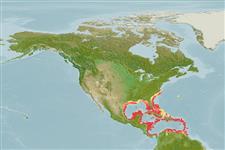>
Eupercaria/misc (Various families in series Eupercaria) >
Lutjanidae (Snappers) > Lutjaninae
Etymology: Lutjanus: Malay, ikan lutjan, name of a fish.
More on author: Cuvier.
Environment: milieu / climate zone / depth range / distribution range
Ecologie
marien rifbewoner; diepte 0 - 100 m (Ref. 36484). Subtropical; 36°N - 9°N, 99°W - 59°W (Ref. 55233)
Western Atlantic: North Carolina, USA to northeastern Brazil (Ref. 57756), including the Gulf of Mexico (Ref. 9626). Common around the Caribbean.
Grootte / Gewicht / Leeftijd
Maturity: Lm ? range ? - ? cm
Max length : 48.0 cm TL mannelijk / geslacht onbekend; (Ref. 55); common length : 38.0 cm TL mannelijk / geslacht onbekend; (Ref. 55); max. gepubliceerd gewicht: 1.3 kg (Ref. 26340); max. gerapporteerde leeftijd: 18 Jaren (Ref. 115050)
Dorsale stekels (totaal) : 10; Dorsale zachte stralen (totaal) : 11 - 12; Anale stekels: 3; Anale zachte stralen: 8. Lower jaw projecting slightly beyond upper jaw; lower corner of preopercle greatly projecting and strongly serrated. Preorbital bone broad, maxilla extending nearly to mid-eye level. Preopercular notch and knob moderate. Scale rows on back rising obliquely above lateral line. Back and upper side gray to dark olive grading to silvery ventrally. Usually with a black spot, about eye size, on lateral line below the anterior soft dorsal-fin rays.
Adults inhabit clear shallow waters over rocky bottoms in the vicinity of coral reefs, less frequently in sandy or seagrass areas. They often form large aggregations during the day. They feed at night mainly on small fish, shrimps, crabs and cephalopods (Ref. 78464).
Levenscyclus en paargedrag
Maturiteit | Voortplanting | Paaien | Eieren | Fecunditeit | Larven
Allen, G.R., 1985. FAO Species Catalogue. Vol. 6. Snappers of the world. An annotated and illustrated catalogue of lutjanid species known to date. FAO Fish. Synop. 125(6):208 p. Rome: FAO. (Ref. 55)
Status op de Rode Lijst van het IUCN (Ref. 130435: Version 2024-2)
Gevaar voor de mens
Reports of ciguatera poisoning (Ref. 30303)
Gebruik door de mens
Visserij: commercieel; sportvis: ja
Tools
Speciale rapporten
Download XML
Internetbronnen
Estimates based on models
Preferred temperature (Ref.
123201): 23.9 - 28, mean 26.6 °C (based on 232 cells).
Fylogenetische diversiteitsindex (Ref.
82804): PD
50 = 0.5000 [Uniqueness, from 0.5 = low to 2.0 = high].
Bayesian length-weight: a=0.01738 (0.00966 - 0.03125), b=2.95 (2.80 - 3.10), in cm total length, based on LWR estimates for this species & Genus-body shape (Ref.
93245).
Trofisch niveau (Ref.
69278): 4.3 ±0.4 se; based on diet studies.
Generation time: 11.3 ( na - na) years. Estimated as median ln(3)/K based on 2
growth studies.
Weerstandsvermogen (Ref.
120179): laag, minimale populatieverdubbelingstijd 4,5-14 jaar (K=1).
Fishing Vulnerability (Ref.
59153): High vulnerability (64 of 100).
Nutrients (Ref.
124155): Calcium = 19.4 [10.5, 31.8] mg/100g; Iron = 0.329 [0.197, 0.581] mg/100g; Protein = 19 [18, 20] %; Omega3 = 0.208 [0.126, 0.343] g/100g; Selenium = 28.1 [13.7, 51.9] μg/100g; VitaminA = 174 [31, 851] μg/100g; Zinc = 0.272 [0.192, 0.417] mg/100g (wet weight);
